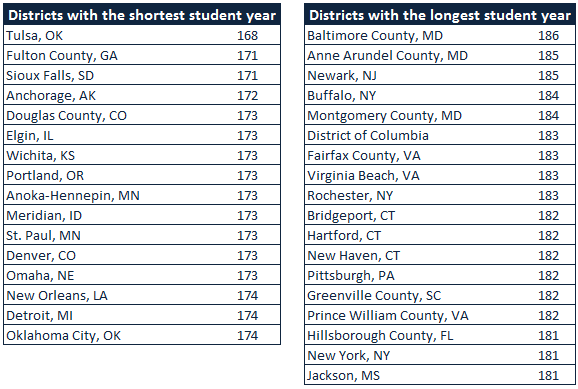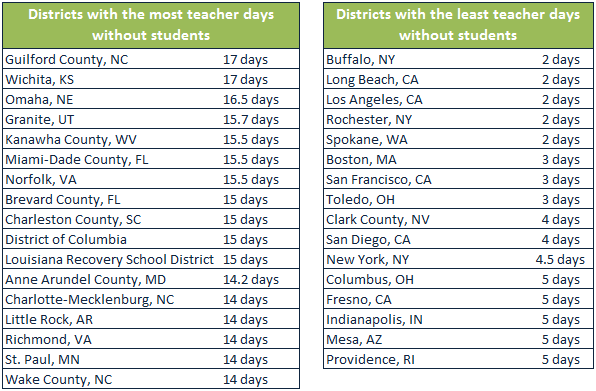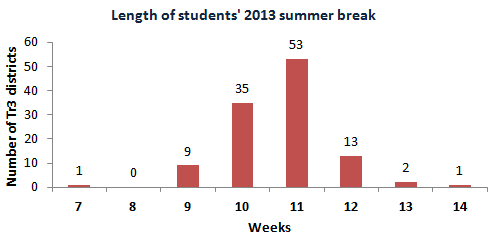August 2013
Welcome to Tr3 Trends, NCTQ‘s monthly newsletter designed just for school district officials (subscribe here). Each month we use data from NCTQ’s Tr3 database to highlight the latest trends in school district
policies and collective bargaining agreements nationwide. Tr3 contains teacher policies from
114 school districts, including the 50 largest districts, the largest district
in each state, Broad Prize winners, Gates investment districts and members of
the Council of the Great City Schools. Teacher policies from all 50 states are also
included.
With the start of a new
school year upon us, we thought we’d take a look at the 2013-14 calendars in
the 114 school districts we track.
Here’s what we found:
The modal student school year length is 180 days, with
16 percent of our 114 districts scheduling a longer year and 50 percent a
shorter year.
The average number of days in
students’ school year is scheduled to be 178 days in 2013-2014. That’s a one day decrease from the 2012-2013
school year.


For the second year in a row,
of all Tr3 districts, Tulsa
has the shortest student year at 168 days. Baltimore
County has the longest year at 186 days.
Click here to see a full listing of student
school year lengths in all 114 Tr3 districts.
In a large majority of
districts, the length of the student school year remained unchanged. Only 12 percent increased their year and 21
percent decreased their year.
The table below lists the
districts that changed the number of days their students are in class from last
year.

On average, teachers will spend approximately 5% (or 9
days) of their 2013-14 work year on-site without students.

Teacher time without students commonly occurs both in
full days and in partial days when students are released early. When
calculating teacher time without students we include both full and partial
days. For example, we’ve calculated that teachers in Guilford
County, North Carolina are on-site a total 17 days without
students. Fourteen of those days are
full days that teachers work but students don’t come to school. The remaining three days come from six days
where students are in school for only half the day.
Click here to view the number of days
teachers are on-site without students in all 114 Tr3 districts.
Students’ summer breaks
ranged from 7 to 14 weeks, and most (77%) had breaks that were 10 to 11 weeks
long.

Indianapolis students have the shortest summer break at 55
days–just under 8 weeks. At 98 days (14
weeks), students in Tulsa have the longest summer break and are closely
followed by DeSoto County, Mississippi (97 days) and Sioux Falls, South Dakota (96 days).
Two districts–Nashville and Indianapolis–have
one-week intercessions in the fall and spring for students in need of
remediation. While both districts have
some of the shortest summer vacations (Indianapolis at 55 days and Metropolitan
Nashville at 69 days), students who do not attend intercession have an
additional two weeks off during the school year.
20 percent of districts delay the first day of school until after Labor Day.
Several districts in major
cities, including Boston,
Seattle and San
Diego all have start dates after Labor Day. New York City
and Philadelphia, however,
clock in with the latest start date, September 9, of all Tr3 districts. On the other end of the spectrum, students in
Nashville start over a month earlier, on
August 1, and are the first students of any Tr3 district to begin their school
year.
Go to Tr3’s custom report page to access all the data we use in Tr3 Trends and to
compare teacher policies in 114 school districts nationwide. Send feedback to gmoored@nctq.org.
